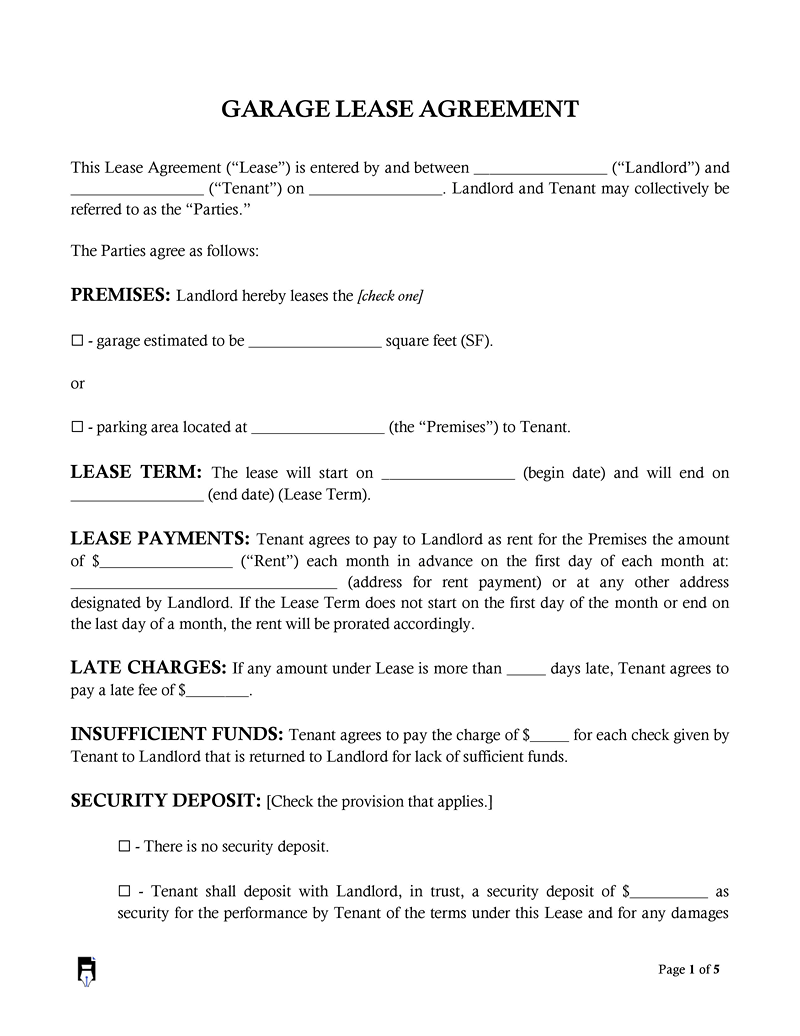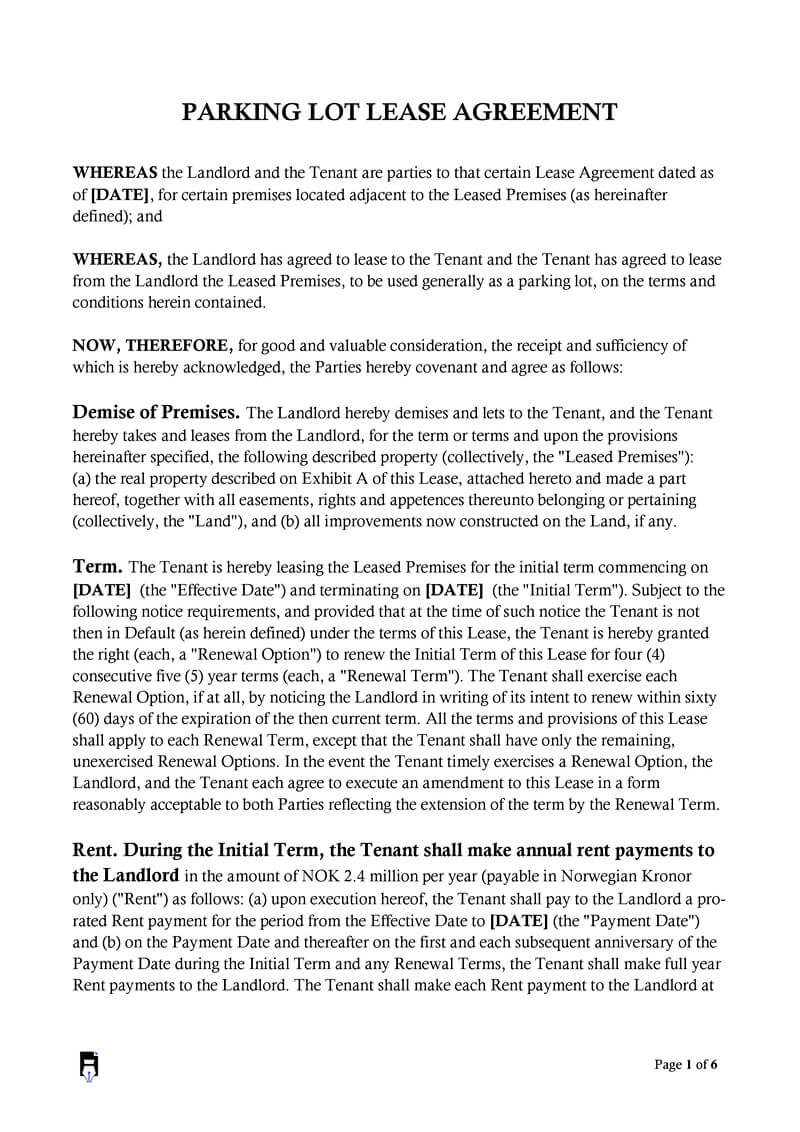A garage is a space or room used to park vehicles or store personal items that are not used frequently. However, if you need to generate extra income, you can lease it to a suitable tenant or applicant. Before leasing your garage space, you must evaluate the tenants and ensure they meet all your demands. Then, you can draft a lease agreement for your garage if the renter satisfies your requirements.
The lease agreement is essential as it protects you and the tenant from exploitation. That means that neither you nor the tenant is allowed to break the rules and regulations of the agreement. Note that the agreement not only protects the involved parties but also offers protection to the property that encompasses the garage space. Therefore, you will need to highlight the rules and regulations to be followed as long as the tenant uses the garage. You can terminate the agreement if the tenant fails to adhere to the rules.
In this article, you will learn more about a garage lease agreement, its importance, and how to prepare it to ensure that your tenant knows the terms and conditions of using the garage space.
Garage Lease Agreement Templates
If you want to create an effective lease agreement for your garage space, you should use a template. You can download garage lease agreement templates free from below. They can be customized to meet and satisfy all your demands. With our templates, you will also be able to create lease agreements for more than one applicant simultaneously.
What is a Garage Lease Agreement?
A lease agreement is a document used by a property owner or a landlord to show that you have legally leased your garage space to a qualified renter.
The garage space can be used for car parking and storing personal belongings of trade equipment. Therefore, this agreement is necessary for places with limited parking or storage area. Additionally, the agreement form is used to outline the conditions of the garage and the rules to be followed once the tenant has started using the garage.
Once an agreement has been reached, the tenant is allowed to use the garage according to the purpose stated in the lease agreement. Therefore, the garage can be renovated to fit the tenant’s needs. Note that you are within your rights to terminate the lease agreement if the tenant fails to adhere to the agreed terms, rules, and regulations.
A garage lease agreement can also be referred to as:
- Parking garage lease
- Garage storage lease agreement
Note: In the lease agreement, you should indicate the payment amount to be collected, the payment method, and the penalties for late payments. In most cases, these lease payments are made monthly. However, this can change depending on the agreement between you and the tenant.
Why Do You Need a Garage Lease Agreement?
As a landlord, a garage lease contract is crucial to you and the tenant. First, the agreement outlines the terms and conditions the tenant must abide by as long as they use your garage. Additionally, it states the period in which the tenant will be renting the garage space. For a landlord, the lease agreement is necessary as it protects your property’s value from depreciating; this means that the tenant must maintain the property in good condition, or they will cater for any damages caused to the property.
Moreover, the lease allows you to oversee and control how the garage space will be used. For example, if the tenant intends to use the garage to park their vehicles, you should have enough information on the number of cars to be parked. If the garage space is to be used for storage, then the tenant should provide accurate details of all items to be stored. Additionally, you can use the lease agreement to limit the number of items stored in your garage.
Additionally, you can limit the tenant from using the garage in any other way apart from the one stated in the lease agreement. Finally, you can include clauses in the agreement to offer extra protection to your property.
Note that a lease agreement is also essential to a tenant. The agreement allows the tenant to understand what is expected of them regarding payment and property usage and how to keep the property in good condition. Furthermore, the agreement ensures that your tenant uses the garage space for the period indicated.
Step-by-Step Guide on How to Lease Your Garage
Without the proper knowledge, renting out a garage can seem like a challenging endeavor. As the property owner, you need to have a good strategy that will help you attract tenants who meet your requirements. Good renters will help protect your garage and give good recommendations to future tenants. In addition, there are specific steps that you should observe when preparing your garage lease agreement.
Keep in mind that the lease’s language depends on the space being rented and the needs of both parties. As the landlord, ensure that you are very specific with the terms and conditions you include in the contract. This makes it easier for you and the tenant to execute the lease agreement.
Here are steps you can follow to lease out your garage with ease:
Step 1: Clean the garage space
It is crucial to remove your personal belongings and clean the floor and walls of your garage space before making them available for rent. A clean garage space makes it easy to attract suitable tenants who will take care of your property. To make the garage more appealing to the renters, you can renovate it by repairing any damages and applying fresh paint.
Step 2: Capture pictures
Once the garage space is clean, you can take some pictures you will use to advertise the garage space. Again, use quality equipment or hire a professional photographer to take good pictures of the space to make the garage look good.
Step 3: Draft the lease agreement terms
Before making your garage space available for rent, it is crucial to draft the agreement terms for potential tenants. The agreement terms should include the rules to be followed when using the garage, the rent amount to be paid, the preferred payment methods, the consequences of failing to uphold the set rules, the location of the garage, and a brief description of the garage space.
Step 4: Post advertisements on social media
Social media is one of the biggest marketing platforms in the world. Therefore, after drafting the lease agreement for your garage, you can post it on all available social media platforms and other relevant websites to make it easy for you to get the perfect clients.
Additionally, you should assess or vet your potential renters to ascertain that they have the required qualifications to rent your garage. This is done by informing them to provide their application documents.
How to Fill a Garage Lease Agreement?
When filling out your lease agreement for a garage space, details must be included to make it complete and legal.
Here are the details you should include in your contract:
Specify the parties
A garage lease agreement should include complete details of the landlord and the tenant. You should include full legal names, email addresses, phone numbers, and physical addresses of both you and your tenant.
Address of the garage
The next step should be to fill in the address of the garage. This is the physical location of your garage. It makes it easier for potential tenants to access the property for viewing.
Details of the space
The contract should also include further details about the parking or storage space. You should include its square footage to provide a proper visual description of the space. The tenant needs to know how much parking or storage space is available. It might be the whole garage space or a specific space. Since this is a legal document, make sure that these details specify the space boundaries.
Rental period
The lease agreement should include the rental period or duration of the lease. This should specify the start and dates of the rental agreement. This will highlight how long you want to rent the garage to your tenant. For example, it can be three months, six-month or 12-month period. You can also choose to have a month-to-month lease.
Use of premises
This section requires you to limit and define the use of the premises. First, the tenant should know how to use the space, whether the garage is meant for parking, storage, or both. You also need to specify these purposes further; for instance, indicate if the parking space is only meant for vehicles or if the storage space is only meant for furniture.
You can also indicate whether your tenant’s vehicle repairs and inspections can be done in the garage or if there are limitations. Finally, make sure that you establish how the garage space should be used.
Number of people who can use the space
You must specify the number of people allowed to use the space. As the landlord, you must indicate if the garage space is limited to the tenant only or can be shared with others. You need to specify these limitations and clearly define who has the right to use the space to avoid confusion.
Rent payment
At this point, the tenant should know most of your terms and conditions regarding the garage. Your next step is to include the rent payment details for each month or the specified lease period. It is advisable also to indicate the due date for rent. Furthermore, if you require the tenant to pay a security deposit, make it clear in the contract. Finally, you can also include any additional fees or expenses expected regarding the space.
Termination of the agreement
The agreement should specify the conditions under which you might decide to terminate the agreement before the lease ends. If your tenant breaches the contract, inform them and give them enough time to correct the issue or vacate the premises. If they refuse to leave once you have terminated the contract, it is best to involve law enforcement.
You can choose to terminate the agreement if the tenant is using the space for a different purpose from what is mentioned in the contract, if they are bothering other garage users, if they are involved in illegal activities in the garage space, if they are subletting without your permission or if they are using the space for longer than the agreed rental period, etc.
Contact information
You must include your and your tenant’s contact details. Include your full name and title alongside the tenant’s full name and contact information.
Signatures
Both you and your tenant must sign the document before witnesses. This is a legal document, meaning this section is necessary. Also, it is crucial to get this document notarized to make it more credible and binding before the law.
Conclusion
Before leasing out a property, it is necessary to draft a lease agreement that will help protect your property. However, the terms included in the agreement will significantly depend on what the tenant intends to do with the property in question. Therefore, you should only consider renting out your garage space once satisfied with the tenant and how they intend to use it.
Note that the garage lease agreement is considered a legal contract. Therefore, it is illegal for either you or the tenant to alter the details or terms of the agreement. However, you should craft a lease agreement highlighting the terms and conditions of your garage space for as long as it is rented out. Use our free-to-download and customizable templates to create a proper lease agreement for your garage.

